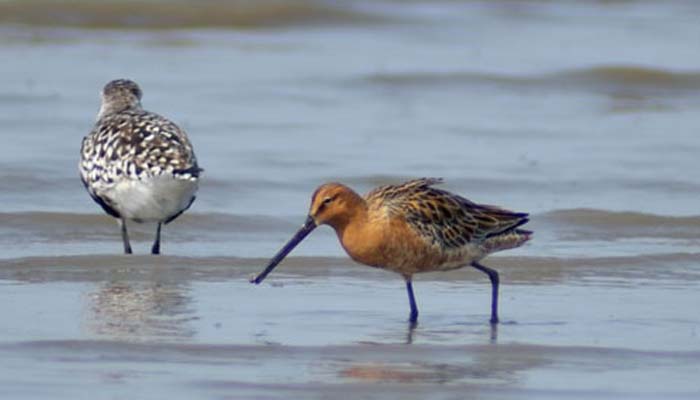
English: Asian Dowitcher
Russian: Азиатский бекасоведный веретенник
Mongolian: Азийн цууцил, Азийн цууцаль
German: Steppenschlammlaufer
French: Becassin d’Asie
Japanese: シベリアオオハシシギ (Shiberia-ohashi-shigi) Status: Rare species. According to the IUCN Red List categories and
criteria, the species evaluated as-Vulnerable.
Distribution and Range: Global distribution includes Russian Federation, Kenya, Yemen,
Kazakhstan, Uzbekistan, India, China and the southeast Asia. In Mongolia: Migrates
through, breeds in the Lakes Valley, the Great Lakes Depression, Khuvsgul,
Khentii, Orkhon and Selenge rivers valley, Mongol Daguur, Khyangan. Breeds near
Airag Orog, Tsaidam, Khuvsgul and Buir Lakes; Boroo, Khalkh and Nomrog Rivers.
Habitat: Shallow water with muddy shores of marshes, wetland meadows and
oases.
Population and Threats: Population undetermined. Endangered due to the habitat
disturbance and loss in nesting and breeding areas reduces the population abundance.
Moreover, fluctuations in water level, sudden cold spells, continued heavy
rainfall, flooding and other adverse climate conditions affect reproductive
success.
Conservation Measures: Hunting prohibited since 1995. Included as Rare animal in the Annex
to the Mongolian Government Resolution #7 (2012), the Red Data Books of
neighboring countries, the IUCN Red List of Threatened Species, the Mongolian
Red Book (1997). The habitat is partially included within the Dornod Mongol,
Mongol Daguur, Nomrog Strictly Protected Areas. Recently, distribution ranges
listed as Ramsar sites in accordance with the Ramsar Convention.
Further Actions: Assess the distribution and population abundance, habitat
protection of areas attracting large numbers of migratory birds by restricting
reed cutting, preventing fires, create conservation management plans for birds
in the NSPAN, organize public awareness program-me.